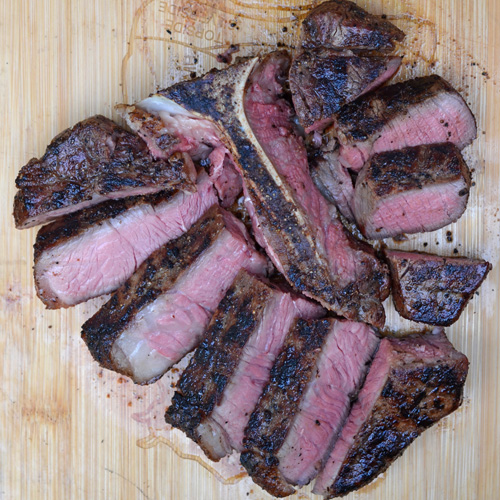Last night, Alexis and I grilled a thick porterhouse steak and improvised a skillet potatoes au gratin. This isn't a recipe post exactly but it is the details of what we did.
We found the beefy 24-ounce porterhouse at Butler & Bailey Market, an unassuming, single-establishment grocer in Knoxville. The store is dated and small, it's like stepping back in time to a grocery store in the late 80's. That's part of their charm, they are the opposite of the chain mega-stores these days. You can't buy tires or mattresses there, Butler & Bailey excels with their customer service and specialty departments. They also sell Parker's Lump Charcoal, which is made with Tennessee hardwoods.
Steak Preparation
The porterhouse steak is two steak in one, the fillet on one side and the strip steak on the other. This one was over 1 1/2 inches thick which made it a great candidate for the reverse sear technique.
- But first I dry-brined it for 4 hours with my NMT Beef Rub v.2 recipe. Dry-brining adds flavor and helps the steak stay juicy during cooking. The basic process coat the steak with salt & pepper based rub or just salt for a few hours before cooking.
- One hour before cooking, I took the steak out of the fridge and let it rest at room temperature.
- Just before roasting the steak, I freshened up the seasoning with some of my finely ground NMT Umami Steak Seasoning recipe, which features dried shiitake, portabello, and porcini mushrooms for their natural flavor enhancers.
- You could substitute any salt and pepper based beef rubs for these two steps but I like the combination of the two that I used.
 |
| I patted the porterhouse dry, put a light coat of peanut oil (about 1 tablespoon) on it, and then seasoned it liberally with my NMT Beef Rub v.2 recipe. I use a resting rack as shown, cover it loosely with plastic wrap, and place it in the fridge until an hour before cooking. I find that the rack allows for better air circulation and salt absorption. |
Skillet Potatoes Au Gratin Preparation
Normally, I start my potatoes au gratin with a homemade cream-based cheese sauce but I had no spare milk, half/half, or cream. So I improvised and made a sauce with
- can of condensed cream of mushroom soup,
- beef stock (one soup can's worth),
- 1/2 cup or so of shredded Oaxaca cheese,
- a fire-roasted Fresno chile, and
- salt, pepper, and garlic to taste
I sliced 3 large Yukon gold potatoes, skin still on, into 1/8th inch slices on my mandolin. I cut them in half and spiral-stacked them in a Griswold #5 cast-iron skillet. I poured enough sauce over the potatoes until they were almost fully covered.
Grill Set-Up
I could have made this work on one grill by adjusting cooking times and temps but since I have a ridiculous amount of grills, I went with a large Big Green Egg and a Mini-Max.
- For the au gratin, I set the large up for indirect heat using a heat-stone and multi-tiered rack. Alternatively, a ConvEGGtor and standard grate would work. I filled the Kick Ash Basket with some Parker's lump charcoal, lit it with a JJ George torch, and preheated the grill to 350°f.
- For the porterhouse steak, I set the Mini-Max up for indirect heat using a Woo Rig, ConvEGGtor, and standard grate. I loaded the Kick Ash Basket with Parker's, lit it with the torch, and preheated it to 250°f.
 |
| I still love my BGE Modelar nest shown with the large Egg on the left. One day, I will probably replace my homemade Mini-Max cart with a BGE Modular Cabinet pedestal but it works for now. |
The Cook
The good thing about this cook is that both dishes take about an hour to cook. So my game plan was to put the au gratin and steak on at the same time. If the steak got done early, I could let it rest until the potatoes caught up. Fortunately, they all finished at the same time.
 |
The potatoes took about 50 minutes to get tender and the sauce rendered down. That skillet is a 70-year old #5 Griswold cast iron that we restored. |
 |
| To finish it, I shredded some cheddar-jack cheese on top... |
 |
| and put the skillet back in the Egg until the cheese was melted, about 10 minutes. |
 |
| The steak took right at 37 minutes at 275°f indirect to reach an internal temperature of 122°f, which is when I wanted to pull it to rest. I used one of my Thermoworks Chef Alarm (affiliate link) remote probe thermometers to monitor the internal temperature during the roast. This remote probe thermometer has a Max and Min temp data logger which makes it easy to tell when the carryover cooking has stopped during the rest period. That is when it is time to sear your steak, per the creator of the reverse sear method, Chris Finney. |
 |
| After the roast and after the sear, I rest my steaks on a clean resting rack. I got into this habit from something I learned on Rouxbe online culinary school. If you put the hot steak on a flat surface, it traps the heat on that one side, steaming the tissues and causing them to release moisture. A rack keeps this from happening. |
The Results
Both were fantastic!
 |
| The steak was perfectly medium-rare, deliciously seasoned, and tender. |
 |
| The skillet potatoes were cheesy, fork-tender, creamy (especially considering I had no milk), and the Fresno chile gave it just the right heat level. |






